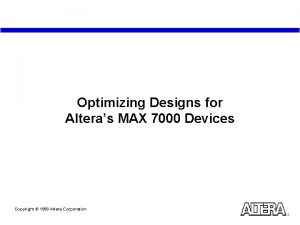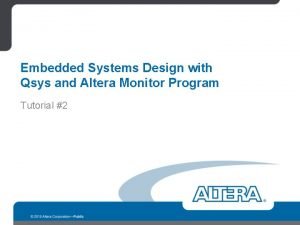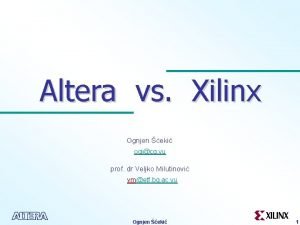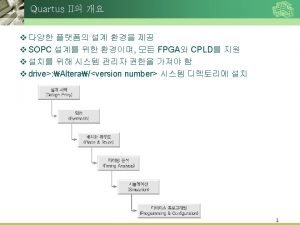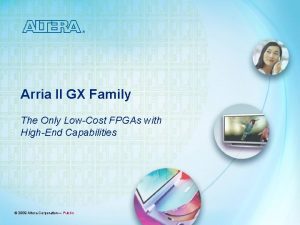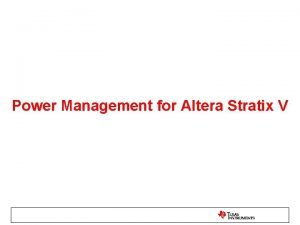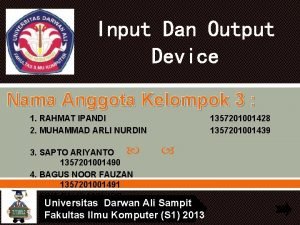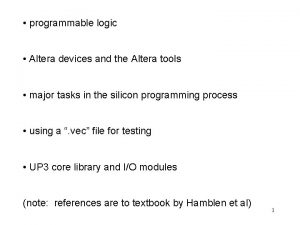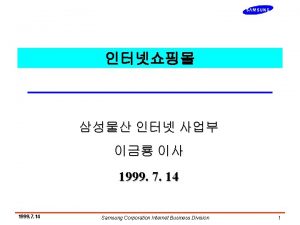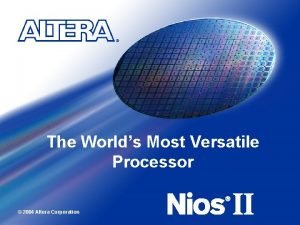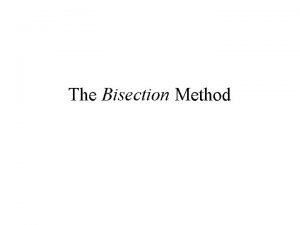ConfigurationProgram Method for Altera Device 1999 Altera Corporation



















- Slides: 19

Configuration/Program Method for Altera Device © 1999 Altera Corporation

Configure FLEX device by Micro-processor 8031 (use the TTF file) © 1999 Altera Corporation

Configure the FLEX Device n You can use any Micro-Controller to configure the FLEX device – the main idea is clocking in ONE BIT of configuration data per CLOCK – start from the BIT 0 n The total Configuration time – e. g. 10 K 10 need 15 K byte configuration file • calculation equation – 10 K 10 * 1. 5 = 15 Kbyte – configuration time for the file itself • 15*1024*8*clock = 122, 880 Clock • assume the CLOCK is 4 MHz • 122, 880*1/4 Mhz=30. 72 msec © 1999 Altera Corporation

Total Configuration time n Total Configuration time (10 K 10) – POR(Power On Reset) + programming bit time + error/status check time + 10 extra clock – POR + 30. 72 msec + error/status check time + 10 extra clock – 100 ms + (error/status check + 10 extra clock) + 30. 72 msec = 130. 72 msec + (error/status check + 10 extra clock) = ~150 msec 100 msec + (error/status check + 10 extra clock) + 30. 72 msec © 1999 Altera Corporation

How about 10 K 100 : (1) 100 * 1. 5 Kbyte = 150 Kbyte = 1200 Kbits (2) assume DCLK = 6 MHz (3) configuration of the POF file itself = 1200 K/4 Mhz = 195 msec (4) Total configuration time = POR + (3) + error/checking + 10 CLOCKS = 295 msec + error/checking + 10 CLOCKS = ~350 msec © 1999 Altera Corporation

PS (Passive Serial) Pin Information © 1999 Altera Corporation

PS (Passive Serial) Mode Pseudo Code © 1999 Altera Corporation

Sample Coding base_address equ 0 ; if define 00000 h, this program compile ROM image. ; Internal RAM usage start at 20 h ; address 20 h-2 fh are bit addressable area ; address 30 h-7 fh are byte addressable area ; P 1. 0 - DCLK (output)("0") ; P 1. 1 - CONF_DONE (input) ("1") ; P 1. 2 - n. CONFIG (output) ("0") ; P 1. 3 - n. STATUS (input) ("1") ; P 1. 4 - DATA 0 (output) ("0") ; P 1. 5 - Done (output) ("0") ; PROGRAM SEGMENT DEFINE org 0 h power_up: ljmp start org 30 h ; INITIALIZE THE 82 c 31 INTERNAL REGISTER start: clr psw. 4 ; select bank 0 (00 -07 h) clr psw. 3 clr ea ; disable the global interrupt mov sp, #50 h ; set up the stack pointer at location #110 mov p 1, #0 cah reset_10 k: setb p 1. 2 ; reset the FLEX device mov dptr, #config_data © 1999 Altera Corporation config_mode: mov a, #0 movc a, @a+dptr rrc a mov p 1. 4, c setb P 1. 0 ; toggle the DCLK clr P 1. 0 ; write the bit 0 rrc a mov p 1. 4, c setb P 1. 0 clr P 1. 0 ; write the bit 1 rrc a mov p 1. 4, c setb P 1. 0 clr P 1. 0 ; write the bit 2 rrc a mov p 1. 4, c setb P 1. 0 clr P 1. 0 ; write the bit 3 rrc a mov p 1. 4, c setb P 1. 0 clr P 1. 0 ; write the bit 4 rrc a mov p 1. 4, c setb P 1. 0 clr P 1. 0 ; write the bit 5 rrc a mov p 1. 4, c setb P 1. 0 clr P 1. 0 ; write the bit 6 rrc a mov p 1. 4, c setb P 1. 0 clr P 1. 0 ; write the bit 7 inc dptr mov a, p 1 anl a, #08 h ; check for n. STATUS bit jz start mov a, p 1 anl a, #02 h ; check for CONFIG_DONE jz config_mode user_mode: setb p 1. 5 user_clock: setb P 1. 0 clr P 1. 0 sjmp user_clock config_data: db 255, 98, 255, 37, 0, 255, 255 Append the “TTF” file here as the Configuration data

How to combine couple SOF to TTF © 1999 Altera Corporation

Recommendation n How fast is the DCLK can go – in the range of 4 ~ 6 MHz n How much of the DCLK, Data can fan-out – around 4 ~6 devices – if need more, add buffer (74244) for every 4~6 devices © 1999 Altera Corporation

PPA (Passive Parallel Async) Pins © 1999 Altera Corporation

PPA Mode Pseudo Code © 1999 Altera Corporation

Recommendation n Make sure have 20 ns setup and 20 ns hold time for the CS/n. CS before n. RS/n. WS active n After finish one byte write, monitor the RDY/n. BUSY signal before next byte is allowed to write – if RDY/n. BUSY is LOW, need to wait until it HIGH n Make sure the “User Supplied Start Up Clock” option has been OFF – under the DEVICE_OPTIONS menu within Max+Plus II © 1999 Altera Corporation

I need 3. 3 V EPC for the 3. 3 V Device n Altera having 5 V EPF 10 K device and 3. 3 V EPF 10 KA device n But Altera only have one type of EPC 1 or EPF 1441 device for both 10 K and 10 KA n Problem is how to control the EPC 1 for the 5 V or 3. 3 V device – the POF for 10 K devices automatic target to EPC 1 5 V devices – the POF for the 10 KA devices automatic target to EPC 1 3. 3 V devices © 1999 Altera Corporation

Convert the 5 V POF to 3. 3 V POF This is the 3. 3 V POF for the same EPC device © 1999 Altera Corporation

Conclusion n You can use your system micro-processor to configure any Altera FLEX device – 8 K/10 K/6 K • You can save the Serial EPROM • DCLK should be in the range of 4~6 Mhz – Don’t forget that you also need to have pull up resistors on n. STATUS, CONF_DONE pins n JTAG Port – JTAG Chain for MAX and FLEX devices • also support NON-ALTERA JTAG devices – JAM for Single/Multiple MAX devices only • also support NON-ALTERA JTAG devices © 1999 Altera Corporation

Cont. . . n PS Port – FLEX Chain for FLEX devices only – can not mix the FLEX devices n FLEX A/E devices I/O accept 5 V, 3. 3 V or 2. 5 V input signal (Multi-Voltage I/O) n EPC 1 is not Multi-Voltage I/O – 5 V power supply accept 5 V signal input – 3 V power supply accept 3. 3 V signal input © 1999 Altera Corporation

Multi. Volt Interface VCCIO VCCINT VCCIO User Option: Allows Interface to 5. 0 -, 3. 3 - & 2. 5 -V Systems Core VCCINT Based on Process: User Connects to Power Supply GNDIO © 1999 Altera Corporation GNDINT GNDIO

cont. . . 5 V 3. 3 V EPC 1 5 V supply to EPC 1 if TDO is 5 V return signal 3. 3 V supply to EPC 1 if TDO is 3. 3 V return signal © 1999 Altera Corporation Only 6 K, 10 K/A/E in this chain (8 K does not allowed in this chain)
 Cpu output device
Cpu output device Concordancia
Concordancia Altera
Altera Qsys altera
Qsys altera Altera vs xilinx
Altera vs xilinx Altera university
Altera university Altera training
Altera training Quartus ii web edition
Quartus ii web edition Basic fpga architecture
Basic fpga architecture Fpga fabric
Fpga fabric Quartus web edition
Quartus web edition Fgpa power management
Fgpa power management Vhdl ppt
Vhdl ppt Altera max 7000 cpld architecture
Altera max 7000 cpld architecture Altera university program
Altera university program Symposium advantages
Symposium advantages A tagout device is preferable to using a lockout device.
A tagout device is preferable to using a lockout device. Kelompok input
Kelompok input Formuö
Formuö Typiska drag för en novell
Typiska drag för en novell


